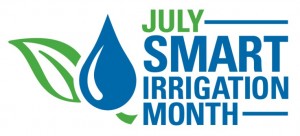Can you believe it’s July already?? July is “Smart Irrigation Month” deemed so by the  Irrigation Association since 2005, because that’s typically when the hottest temperatures occur. With high and hot temperatures come higher water use, it’s just a given. We still want our landscapes to look as good as they have the rest of the year, so we crank up the water.
Irrigation Association since 2005, because that’s typically when the hottest temperatures occur. With high and hot temperatures come higher water use, it’s just a given. We still want our landscapes to look as good as they have the rest of the year, so we crank up the water.
It’s been a slightly different year already: we haven’t had a 100-degree day yet! We’ve only had a handful of 90-degree days! And, we’ve been inundated with rainfall all throughout May and June (which have refilled the lakes! Yay!); so we really haven’t needed to use the irrigation system at all so far this year.
That’s all great news! But now that it’s becoming increasingly hot and muggy, I know we are itching to turn on those sprinklers! Before you do, I advise you to do a quick check of the system, to make sure it’s working properly. Details of how to this are below:
Performing a check of the irrigation system, (aka an Irrigation Evaluation, or Irrigation Audit) is the cornerstone for maintaining the system. If you are a direct water customer of Round Rock, Water Conservation staff (that’s me) will schedule and do this for you; however, it’s simple enough that you could do it yourself—and it’s highly recommended to check you system monthly! I recently found a broken head on my own system that I hadn’t noticed or even realized was there, that got hit when the grass was last mowed. So, how do we check it?
- First you need to go to the controller and turn the dial to “test” or “system test” if that option is there (Rainbird controllers have this). If you have this option, great! The number you see in the display are minutes that, once started, will run each station for x minutes and then turn off. A good default number is 2 minutes. After selecting 2 minutes, push the manual start button on the controller to begin the system test.
- If you DO NOT have the “test” option on your controller, you can simply program one in. Just choose a program that you are not using for your normal watering cycle—probably the C program. You don’t need to enter in start times or water days, only watering times; so for each of your stations, enter a runtime of 2 minutes. Then start the program manually.
- Once the system is running, you are looking for problems, issues like sprinkler heads turned the wrong way and spraying the street, rather than the grass. Or heads that do not pop-up over the grass (that’s why there’s that dry spot!), or heads that are clogged, and no water is coming out of them. You could also look for leaking heads, broken nozzles, and other leaks. For an idea of what some of this looks like, see my blog “What is Water Waste?” from last month.
- The simplest, and most worthwhile, thing to fix is misdirected heads; most of them can simply be turned to face the appropriate direction by using your hand to grab the head (essentially the neck) and physically turn it. This prevents water waste, poor coverage, and ensures the water is used, rather than running off the property; all of which are positives for you and your property.
- Nozzles that are clogged are easily be cleaned out (when the system is turned off!). Unscrew the nozzle, rinse it and the filter off, and screw it back on. You may use an old toothbrush or toothpick to clean out the emitter where the water sprays out of the nozzle, it’s pretty small. Once screwed back on, turn the system on to make sure you have put it on facing the correct direction and it’s watering what it needs to be.
- Low heads or heads that do not pop-up over the grass is due to either too tall grass, which is really not a bad thing, usually, or more likely, the heads have settled over time and just sunk into the ground. They need to be replaced with taller heads in order to have better coverage—to get the water out far enough to water what’s it’s supposed to. You can replace this head yourself with a taller head (they are sold by height in inches, so if you have a 4” head currently, you may increase to a 6”), or depending on the amount of low heads, you may hire a licensed irrigator to do this, as there is a degree of professionalism needed. You don’t want the heads sticking up over the grass and become a hazard when the grass is mowed.
So that’s the basics of performing a system check! Do it monthly to actually see how the system is working, that what is supposed to be watered is actually being watered, AND, most importantly, make repairs and adjustments to the system to keep it running efficiently!


